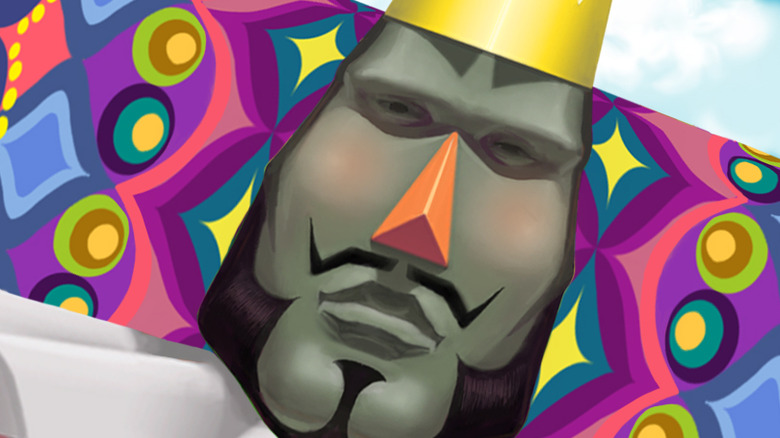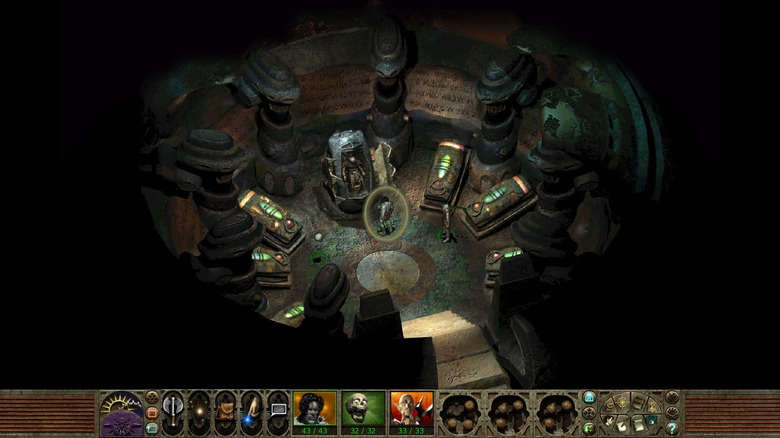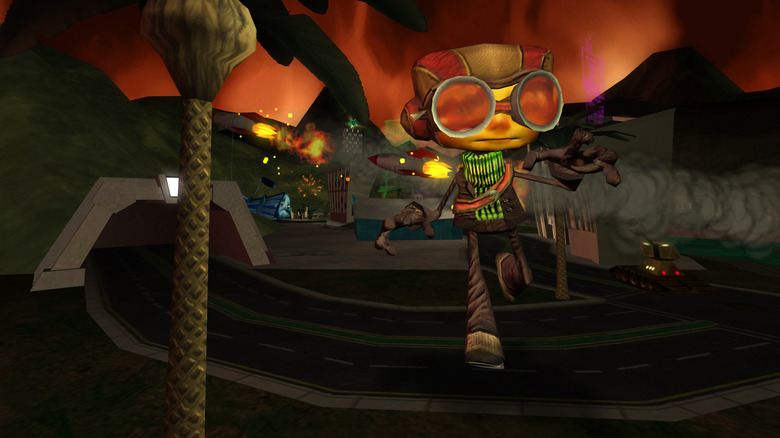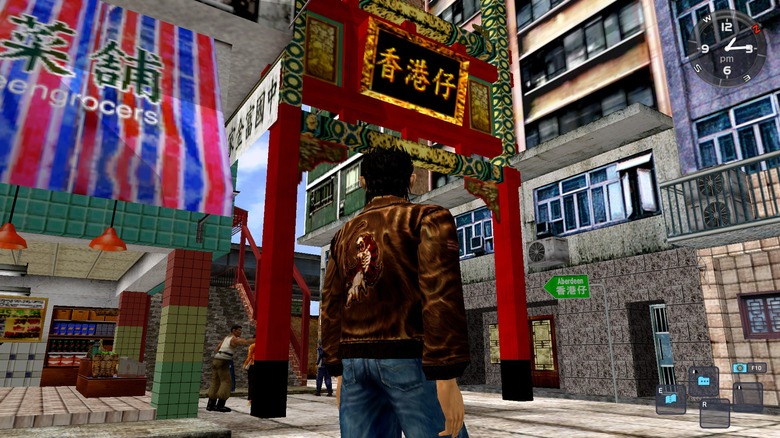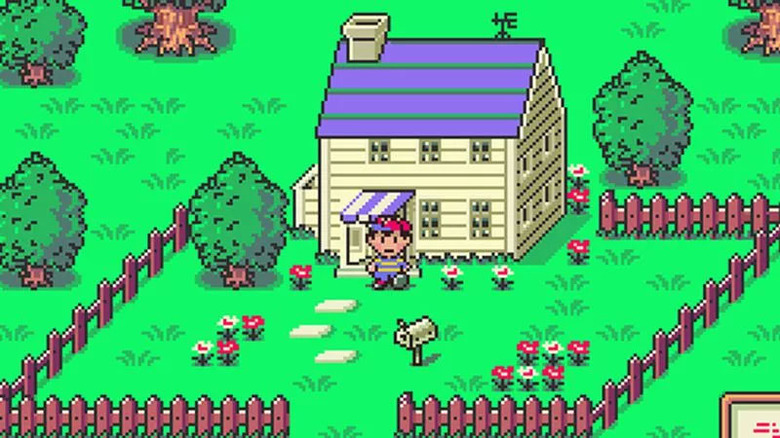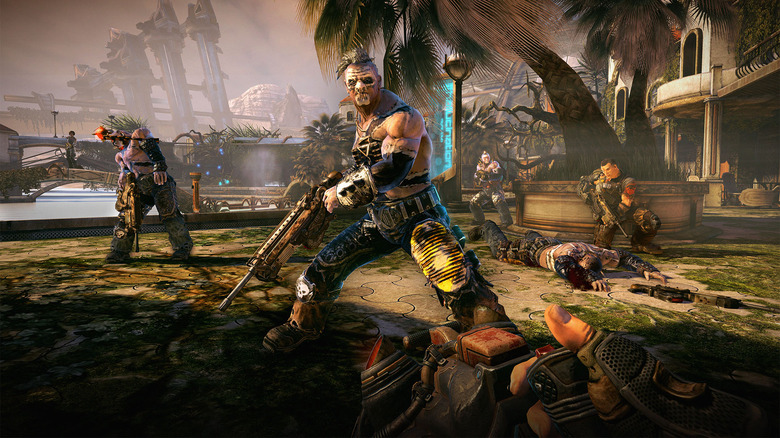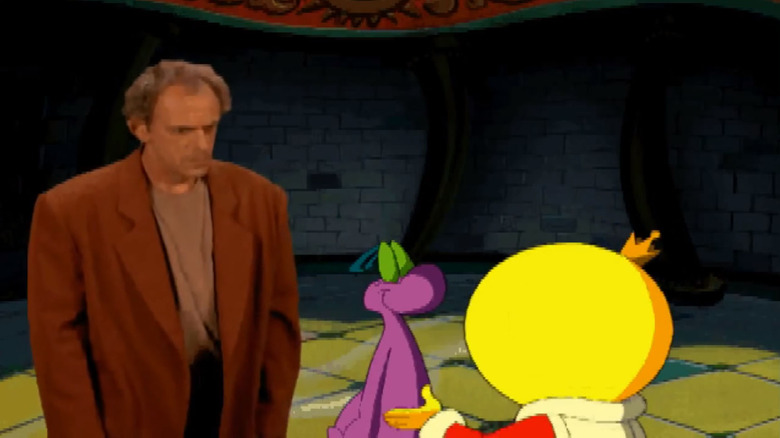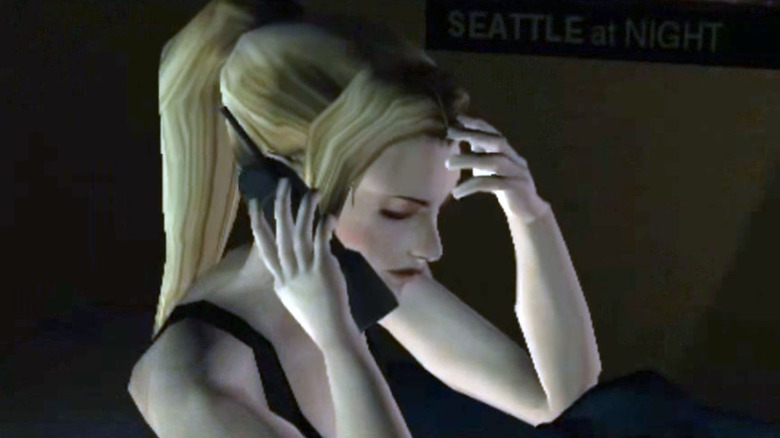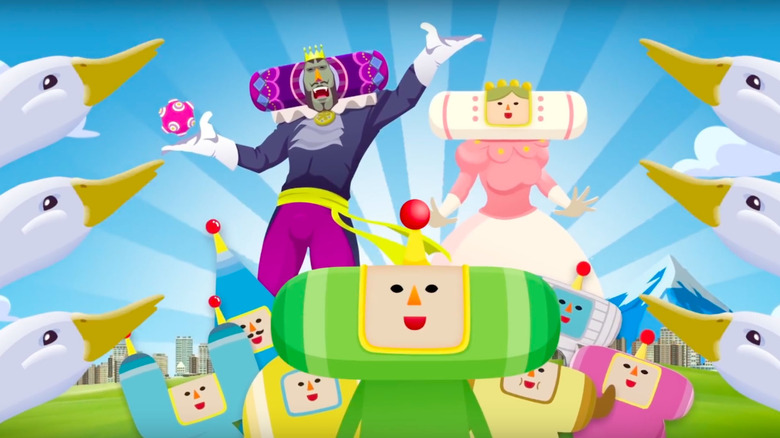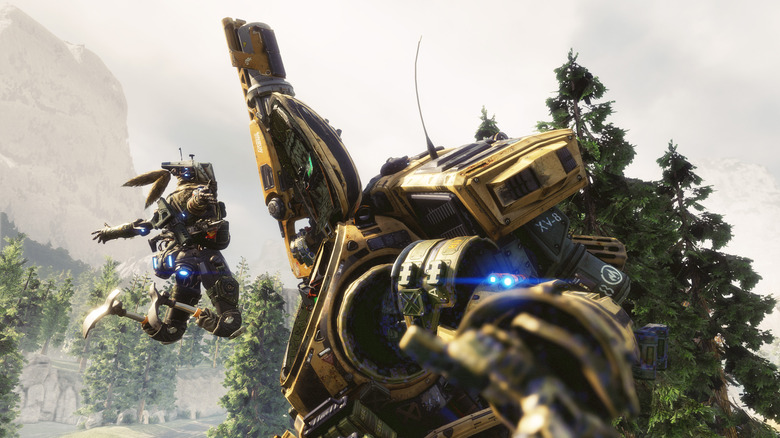Gaming Bombs That Somehow Became Cult Classics
It's hard to keep a great game down. Oh, people will try. They'll saddle a perfectly good title with a lackluster or tone-deaf marketing campaign. They'll release a promising game on a dying or underpopulated console, or make changes to the software at the last minute, resulting in a product that's very, very different from what consumers were promised. Good games bomb all the time, and there are all kinds of reasons why.
Like life, however, gaming finds a way. Not enough sales? Too hard to find a way to play? If a game has the chops, it's no problem. Games like these may never have as many players as Minecraft or Call of Duty, but they still have a special place in fans' hearts. If you overlooked the following titles, maybe try them again. Who knows? Like they say, every game is somebody's favorite. Maybe one of these is yours.
Planescape: Torment's tortuous sales
Even when it was released, Planescape: Torment was an oddball. While Baldur's Gate took place in Dungeons & Dragons' relatively straightforward Forgotten Realms universe, Planescape: Torment utilizes D&D's lesser-known Planescape setting, which is fundamentally weirder and less comfortable than its Tolkien-esque traditional brethren. Visually, Planescape doesn't look like any role-playing game made before or since, and the language takes some work to understand. Given that Planescape: Torment is chock full of text, that can be a problem.
As a result, it's no wonder that Planescape: Torment didn't sell as well as Baldur's Gate, Fallout, or many of the other games produced during the computer-RPG heyday. By all accounts, Interplay Entertainment considered Planescape a commercial disappointment. Lead designer Chris Avellone thinks he knows why. Planescape's setting is too weird, he tells RPGWatch. It starts slow and requires too much reading. It was marketed all wrong.
Underwhelming sales didn't stop Planescape: Torment from becoming one of the most influential and respected role-playing games of all time, though. These days, critics and RPG fans alike credit Planescape with pushing the genre to its limits thanks to its emotionally mature storyline, real role-playing opportunities, and some of the best writing ever found in a video game. Sure, Planescape has a lot of words, but when they're this well written, most RPG aficionados don't seem to mind.
Psychonauts blows minds, flops anyway
Psychonauts is more or less the poster child for great games that flopped only to become retroactive classics. It wasn't that people didn't like Tim Schafer's surreal 3D platformer. It's that nobody seemed to care. Microsoft didn't get the game, and ultimately canceled the project. Next, it was picked up by Majesco, which didn't market or distribute the game all that well. A month after launch, Majesco drastically revised its financial outlook for 2005 and ultimately left the console game business. Psychonauts often takes the blame.
But Psychonauts proved hard to kill. It's just got too much personality to fade away. Years after launch, Double Fine's psychic-powered adventure got a reputation as one of the best games that nobody ever played. When the studio got the Psychonauts rights back from Majesco in 2011, it capitalized as quickly as possible. An appearance on Humble Bundle in 2012 sold more copies of Psychonauts in a couple of hours than during the game's entire retail run. At long last, people were discovering Psychonauts, and they wanted more.
They proved it, too. When Schafer and his cronies launched a Psychonauts 2 crowdfunding campaign, fans showed their love to the tune of $3.8 million. Why not? As anyone who's played it knows, Psychonauts is funny, creative, and surprisingly morose — but you've got to play it to figure that out. Thankfully, you've got a second chance.
Shenmue was the right game on the wrong console
Shenmue was bound to fail. Not only was it the most expensive video game ever made at the time of its release, but it came out on the Sega Dreamcast, a fantastic console that failed to make a dent at the marketplace. In order for Shenmue to break even, every Dreamcast owner would've had to buy two copies of the game. Obviously, that wasn't going to happen.
While Shenmue's sales figures would've been decent for any other title, the game was simply too expensive and its potential audience too small to succeed. Shenmue's failure is often cited as one of the reasons why Sega was forced to abandon the console manufacturing business, and the game's high cost and low returns made a potential sequel (after 2001's Shenmue II) a no-go for over a decade.
Despite the disappointing sales, however, Shenmue's legacy lives on, and over the years it's proven to be ahead of its time. Shenmue let players explore an open 3D world a couple of years before Grand Theft Auto III dropped everyone into Liberty City. It popularized (and named) quick-time events (or "Quick Timer Events" as it called them), and regularly ranks on lists of the greatest games ever made. That's why they happily crowdfunded a sequel, shattering records in the process, and can't wait for the first two games' long-demanded remasters. Shenmue may not have saved Sega, but it had a profound impact on video games themselves.
Was EarthBound bound to fail?
Try to find a game with a more dedicated fanbase than EarthBound (known as Mother in Japan). Since the quirky Super Nintendo role-playing game came out in 1994, EarthBound die-hards have kept the game alive by producing virtual tons of fan art, music, and stories. When Nintendo refused to translate EarthBound's sequel into English, the fans went ahead and did it on their own. They also produced a 200-page, full-color player's guide, are working on an unofficial follow-up, and transformed a site hawking EarthBound-themed merch into its own business. On eBay, copies of EarthBound regularly sell for around $150, over twice what the cartridge was worth brand new.
Of course, there's a reason why people pay so much. When EarthBound arrived in America, it tanked. Nintendo sold fewer than 150,000 copies of the game, well below the company's expectations. Many analysts blame EarthBound's marketing campaign and its simple graphics for the lackluster showing. In fact, thanks to EarthBound's poor North American sales, the game never came out at all in Europe. As a result, EarthBound cartridges are very hard to come by. Throw in the game's soundtrack, which kept EarthBound from getting a digital re-release for years, and you end up with a game that's historically been absurdly hard to play.
These days, you can play EarthBound on the Wii U's Virtual Console or on Nintendo's Super NES Classic Edition, which means more people than ever are now privy to EarthBound's oddball charms.
Taking shelter from the Bulletstorm
Bulletstorm has cult classic written all over it. It's unabashedly violent. It's extremely profane. It's campy, vulgar, and gloriously absurd. Bulletstorm is the video game equivalent of a movie that screens at midnight at your local arthouse theater, or the late-night schlock fests found on cable television. Everyone involved with the game seems to realize that they're not making high art, and that gives them the freedom to cut loose and have some fun.
It also didn't sell very well, which is another factor that qualifies Bulletstorm for cult classic status. Mike Capps, the president of Bulletstorm's publisher Epic Games, told Kotaku that Bulletstorm "didn't make money," while publisher Electronic Arts claimed that the game "under-performed." The game's juvenile attitude might've worked against it, too. Before release, Fox News implied that Bulletstorm was the "worst video game in the world," and called out the game's innuendo-heavy skillshots, which give players points for dispatching enemies as violently as possible.
Of course, creative uses of gore and profanity are exactly what fans of cult cinema crave, and despite its lackluster reception, Bulletstorm has become known as an underrated, brief, sci-fi romp. We may not ever get a sequel — the original's sales saw to that — but a remastered edition hit a few years back, in case you missed Bulletstorm the first time around. If you miss Duke Nukem's glory days and have an afternoon to spare, pick Bulletstorm up. You might find yourself pleasantly surprised.
If only more people had been lovestruck by Toonstruck
There's more than a little bit of Who Framed Roger Rabbit? in Toonstruck's DNA. Like Robert Zemeckis' cartoon noir, Toonstruck plops live-action actors into a cartoon world. It stars Christopher Lloyd, who played Roger Rabbit's evil Judge Doom, in addition to popular actors like Tim Curry and David Ogden Stiers. But Toonstruck isn't just a Roger Rabbit riff. Its plot, which involves a war between various cartoon countries, is more epic than anything Roger could possibly imagine.
So, what went wrong? Richard Hare, Toonstruck's lead designer, has some thoughts. The cartoon aesthetic, Hare says, made people think the game was for small children. By the time that Toonstruck hit store shelves, point-and-click adventure games were losing popularity. The game's box art was "truly awful." Toonstruck also wasn't finished: development took longer than planned, and Virgin Interactive decided to cut the game in half in order to get it out the door. All of the cut material was saved for a sequel. Then Toonstruck flopped, and the follow-up was canned.
The incomplete storyline has proved to be fertile ground for fans, however, who seem more than happy to fill in the blanks. One group started their own fan-made sequel. Toonstruck 2 is the subject of a popular creepypasta. A Facebook group dedicated to the unreleased game has become a place for fans to share their Toonstruck memories. If Toonstruck had been finished, maybe it would've faded away. But it wasn't, and the mystery has kept Toonstruck fans engaged for over 20 years — and counting.
A eulogy for Eternal Darkness: Sanity's Requiem
If you've read about Eternal Darkness: Sanity's Requiem, it's probably because of the game's mind-bending "Sanity Effects." As you play through Eternal Darkness, your characters slowly lose their minds, and the game tries to make you do the same by breaking the fourth wall to create some of the most paranoia-inducing scenes in video game history. At times, Eternal Darkness pretends to boot to the title screen, tells you its lost your save file, or makes it look like your television is broken. It'll really make you feel like you're going mad.
There's more to Eternal Darkness than tearing down the fourth wall, of course. The game is one of the few Lovecraft adaptations that really gets cosmic horror, and the complex multi-character, multi-timeline plot is more ambitious than your typical video game storyline. It's one of the best games to ever appear on a Nintendo console. Too bad that console was the GameCube. Not only was Nintendo's little square machine one of the company's lesser efforts sales-wise, but die-hard gamers tended to dismiss the GameCube as a children's toy — and, if you haven't noticed, Eternal Darkness isn't exactly kid-friendly.
And thus, Eternal Darkness bombed, selling fewer than 500,000 copies. Since then, Nintendo has kept the Eternal Darkness trademark active, but with its developer, Silicon Knights, brought low by lawsuits, a sequel seems unlikely. Almost everyone who's played Eternal Darkness sings its praises, but that's the problem: you've got to find someone who's played it. Very few actually have.
Selling Katamari Damacy was anything but a ball
It's hard to imagine that a game with eight sequels was a bomb, but guess what? Katamari Damacy managed to do it. Look, we get it: Keita Takahashi's unique puzzle-action game isn't normal. In Katamari Damacy, players roll around a ball made out of stuff, collecting items off of the ground so that the ball grows, meaning that it can absorb even more stuff. It's not just weird. It's very, very weird.
That's probably why the very first Katamari Damacy didn't do all that well in the marketplace. Namco, which published the game, expected to sell roughly half a million copies of the game in Japan, a mere fraction of what 2004's best-selling titles managed to score. Katamari Damacy doesn't appear to have managed that. In the United States, where Namco decided to release the game after a strong showing at game industry trade shows, Katamari Damacy only around 120,000 units (the game was too strange to get a European release at all).
Katamari Damacy didn't tear it up at retailers, but critics loved it. The Academy of Interactive Arts and Sciences and the International Game Developers Association showered it with awards, while Namco decided to greenlight a sequel almost immediately. That sold much, much better, thanks to the original game's quickly growing reputation. These days, Katamari Damacy is the cornerstone of an entire franchise, has inspired all kinds of weirdly wonderful titles, and has a permanent home in New York City's Museum of Modern Art. Y'know, that's pretty darn good.
Why didn't anyone take the plunge with Titanfall 2?
In a day and age where developers are going all-in on loot boxes and games as a service, Titanfall 2 stands apart by delivering everything that shooter fans say they want. Call of Duty may not have a single-player campaign, but Titanfall 2 does, and it's excellent. Tired of shelling out money for yet another premium "season pass?" Titanfall 2 gives you all of its extra content for free. Wary of multiplayer games with broken progression systems and warmed-over player-versus-player combat? Titanfall 2 has mech-based combat that fuses first-person shooters with fighting games and MOBAs, and that provides enough customization options to keep the game fresh for years to come.
If people play it for that long, anyway. Despite Titanfall 2's strengths — and it's got a lot of 'em — it crumbled in the face of competition. While Electronic Arts hoped to sell nine to ten million copies of Titanfall 2, the publisher also decided to release it against Call of Duty: Infinite Warfare and EA's own Battlefield 1. As analysts predicted, the newer franchise couldn't pull its weight. Titanfall 2 floundered, failing to meet either EA's expectations or the bar set by the first Titanfall. That's a shame. As anyone who's played Titanfall 2 will tell you, there are only two kinds of people in this world: those who like Titanfall, and those who haven't played it. Make sure that you're one of the former.
Amplitude hits all the right notes, and yet...
With the one-two punch of Guitar Hero and Rock Band, Harmonix transformed in the mid-'00s from a beleaguered indie developer into a game industry rock star, but it wasn't an easy road. Not only did Harmonix turn to video games in order to fend off bankruptcy, but the studio's first two games, Frequency and Amplitude, were amazing rhythm-action games that, in the words of Harmonix art director Ryan Lesser, sold like "peanuts."
Frequency and Amplitude look a lot like Guitar Hero. In both games, you need to hit buttons to catch notes traveling along a track. But while Guitar Hero's rock star fantasy is easy to explain, Frequency and Amplitude don't screenshot as well. "If you hadn't tried out the game, it made no sense," Harmonix's Alex Rigopulos says. Combine that with a soundtrack that didn't cater to popular music tastes, and you ended up with great games that just didn't appeal to a mass audience.
The audience that did like them, though, really liked them. Unlike Guitar Hero and Rock Band, Frequency and Amplitude are dead hard, and so-called "Freqs" — i.e. fans of Harmonix's earlier, more brutal games — say that when you get into the zone there's nothing quite like 'em. That's why over 100,000 fans decided to donate close to a million dollars to fund an Amplitude reboot. Amplitude and Frequency may not be mainstream titles, but that's okay. In the eyes of their fans, they're already perfect.

